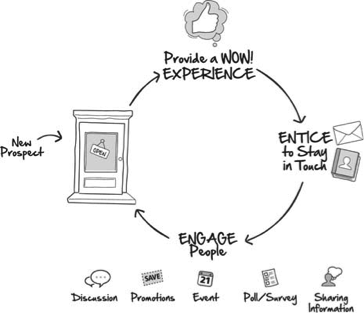- December 5, 2013
- Posted by: Raz Chorev
- Category: Misceleneous

Engagement marketing has been a buzzword for the past few years, with the growing adoption of social technologies amongst consumers. I have found that despite the fact that corporate marketers personally use Social Media in their personal capacity, there’s a big disconnect between what they perceive as their personal preference when they are being marketed to via social channels, and what they actually produce on behalf of their employer.
Before I get into the steps or considerations required to develop an Engagement Marketing Strategy, I’ve put together a list of assumptions (I wanted to call them facts, but I’m being slightly cautious) marketing professionals should consider, no matter how small or big their business is:
- Social Media is for people. Not entities. Although people have strong connection with brands, such as Coca Cola, Harley Davidson, etc. people need to know why they should engage with a company, and connect to an organization’s social media assets. What are they going to get? What’s in it for them? Is there a one-off benefit or a long-term relationship? Ensure that it is easy and compelling for them to connect, and then ask them to! People are more likely to join if they’re asked. (Yes, they really have to be asked!)
- Buyers trust comments and reviews (even from strangers).
According to a Nielsen Global Trust in Advertising Survey, only 14% of people trust advertising, while 78% of people trust consumer recommendations. When businesses interact with current customers online, these socially visible interactions feed their referral engine. Amazon.com and eBay.com figured this one out years ago. TripAdvisor, Yelp, Foursquare and many others are recommendation engines used by hundreds of millions of users globally, before making a buying decision. Whether I’m interested in a book, a restaurant or a holiday, I’ll be more trusting of my fellow consumers actual experience, than just the marketing massages from the sellers..
- Engagement drives social visibility.
Social proof is the concept that when we see our friends and colleagues take an action, such as a purchase of any sort, that action is an endorsement. Social proof happens through social visibility. When people engage with a business – especially online via social media – their networks see this engagement, enticing them to engage, too.
- Engagement matters.
Engagement cements a connection between a business and their current customers, and drives the social visibility that will motivate and inspire repeat and new business. Engagement happens in small doses. It’s not a one-off campaign, or something you can start and let go, or even switch off…
Telstra learned that valuable lesson in 2009, when they’ve decided to shut down a blog (NowWeAreTalking.com.au) they’ve been running for 4 years, in their words: “as an experiment”. The backlash wasn’t pleasant, and left many people bitter and angry…
- Customer’s friends are the business’s next best prospects.
We all want to find a rich source of qualified new prospects. Turns out every business already has one! The social networks of your current customers are filled with people like them – people who might be interested in your products or services. A recent research conducted by two marketing professors at Wharton Business School (David Bell & Jeonghye Choi) illustrates the relationship of consumers and their networks and its influence on online sales.
- Competition is fierce! To survive you’d need to rise above the ordinary in both small and large ways that wow customers. To create a connection, understand the experience your business delivers through a customer’s eyes…and find one or two spots to create something a little bit special. Creating a WOW effect stems from expectation management. Jim Collins, (known for his bestselling books Good to Great, and Build to Last) claims that Good is the enemy of Great, which mean that if you know what people expect (through research and true listening), you’ll be able to add a little “cherry” to make the customer go “WOW”. This of course is very important at all sales stages, but arguably the most important in customer service, AFTER the sale has been made, especially when dealing with complaints…
Engagement Marketing Considerations
There are many companies and organizations that have transformed their marketing strategy from outbound to engagement marketing. One excellent example is the global recruiting firm Aquent (incorporating the Australian Firebrand Talent), who have a focus and expertise in hiring digital and marketing personnel. They’ve realised that in order to really know the community they are helping their clients to recruit, they need to “walk the walk” – create content and actively engage with their community and stakeholders. They Blog (verb) (including their CEO, Managing Director, and other top executives), they tweet and they respond to communications directly and quickly.
In a recent engagement I had with Aquent’s Global Head of Marketing, Carolyn Hyams, we’ve discussed the main focus areas to look at when considering Engagement Marketing as a corporate marketing strategy. This of course has no relevance to the size of the organization – these areas apply to all entities, from large, global enterprises, to NFP organizations and even small businesses. The scale of implementation will obviously be different:
1. Start at the top, and have an Executive Buy-In
This strategy need to be not only adopted by the executive team, but endorsed and be their focal point, as the organization’s strategic approach. Engagement with the community means that you’re no longer just pushing out messages and hope for clients to come rushing in; It means you’re having conversations, providing additional value, and learning from your customers. This also means you’d need to make some organizational changes as the result of the feedback you will receive. The executive team need to be on board, and actively engage and participate in conversation (writing blogs, tweets, record Video content, etc…). PERSONALLY!!!
2. Allocate time
Time is the main resource that seems to be scarce when considering engagement with customers. Not only with the daily /hourly interaction, but the understanding that it will take time to foster relationships, to earn trust, and to build reputation and confidence. It will take time to build a following and a community. It may take a LONG time to establish enough credibility, to test and measure different tactics, in order to get the community to engage with you, openly and candidly. This shouldn’t deter you from starting though – as Social Media is here to stay, in one format or another, and the shift in the way people communicate is permanent. You’d need to start sooner or later, and the sooner the better!
3. Be Authentic
No one knows your business better than you do! PR and Advertising agencies have their place when creating content and crafting messages. They help the marketing, communications and PR internal resources to execute on various campaigns. They can’t replace or substitute internal resources when it comes to authentic engagement, by people who care about and proud of their company, their products and services, and their clients.
4. Allocate Human Resources
Although Social Media is largely free, time isn’t. To be authentic, people within the organization have to have the training, the know-how, and the right attitude. They also have to be trusted with the company biggest assets – Brand and Clients! When hiring or appointing people to have such responsibility, you must take into account that responsibility. Hire smart!
5. Create A Repeatable Framework
Areas of focus would include a content calendar, a crisis management framework including an escalation process, define roles and responsibilities and establish KPI’s to track success and progress.
6. Invest in Technology
There are many software solutions to enable Engagement within the organization, and outside of it. They include Email Marketing solutions (Constant Contact, Mailchimp and many others), Blogging platforms (WordPress, Drupal, Blogger, amongst others), Social Media Monitoring and Engagement platforms (for external communities) such as Hootsuite, Sysomos Heartbeat, Radian6, Nuvi amongst others, Wikis, Forums, Video platforms (YouTube, Vimeo, Viddlr, etc…) all the way to social intranets and Enterprise Social Networks (Telligent, Jive, Tibbr, etc…) to facilitate engagement on a whole different level!
Most of those tools start with a free (or very affordable) offer, and end up with enterprise offering, including analytics, team collaboration, security and workflows and many other features not available on the basic offers.
Choose the most appropriate technology for your OWN NEEDS (first define the needs, then find the solution!).
7. Measure, Analyse, refine
It may be easy to measure quantitative data, yet it won’t represent the full picture. Measuring the numbers of likes, shares, comments, views etc. will be vitally important, but not enough. There’s a need to conduct deep analysis of conversations, content, authors, influencers, sentiment, and other factors to see the full picture. As described above, Engagement is not a once-off exercise, but an ongoing activity, therefore will require constant measurement and analysis of the data, to enable learning and refinement of processes, and ultimately products and services.
Making the transformation (yes, this is a complete transformation!) from the traditional marketing approach to a full-blown Engagement Marketing Strategy isn’t an easy feat. It takes time, dedication, learning and understanding, frameworks and resources. But most importantly – have the bravery to experiment, humility to acknowledge small failures and mishaps, and the courage and dedication to learn and keep moving forward!
2 Comments
Comments are closed.


This is an excellent article and I thank you, it is ultimately people connecting with people who share a commonality. It is hence the reason why I believe companies should capitalize on their biggest asset being their employees to engage with their respective audiences. via their Personal Brand. Their brand that endorses the company values, product and services making exceptional brand ambassadors.
Thanks Diana – I agree wholeheartedly!